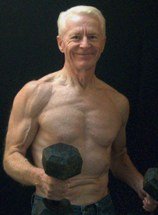


In this letter . . .
What is Periodization Training?In my beginner’s book for seniors, I explain a straight-line progression plan for building strength and fitness. You begin lifting a weight that is manageable without straining for 12 repetitions. At your next training session, you do 13 reps. Then 14 at the following workout and, finally, 15.Then you add 5 to 10 pounds to the bar, go back to doing 12 reps, and begin the progression over again. It works in a similar way with cardio. Say that you choose walking for cardiovascular exercise. At each workout, you add some minutes to your total. That is how classic straight-line strength and fitness progression works. It is a solid beginner's plan — for a while. But eventually you hit a wall. Call it what you want, a “sticking point,” a “plateau,” or whatever. The thing is, if you simply try to push through it while doing the same things in the same way, you inevitably experience physical or psychological burnout. The great Russian weightlifters realized this long ago and came up with an effective training protocol known as periodization. It works, more or less, like the following:
Following the active rest period, they would begin another cycle. You may not be a power lifter or want to be one; nevertheless, once you have progressed beyond the beginner stage, almost all training, whether it is for a particular sport, bodybuilding, or general conditioning, ought to follow a somewhat similar format of: 1) gradual buildup; 2) peaking; and 3) backing off for a bit (active rest). Most of us are not in competitions. Still, the principle remains the same. Test your limits once in a while, but trying for a personal best at every workout only leads to dreading your training, to possible injury, and to eventual failure. Train with variety. Mix it up. Change your routine. Do high reps for a while. Then switch to medium reps with heavier weights. You get the idea. For cardio, push to better yourself for a period. Point toward a goal. Maybe add some sprints. Then back off and do something different and with less intensity for a couple of weeks. Not only will you make greater progress, I'll bet you will enjoy your training more.
How Big is Your Hippocampus?I promise this has nothing to with that cheesy TV ad featuring Smiling Bob and his friends who are envious of his anatomy.But when it comes to the hippocampus, a brain structure vital to certain types of memory — size really does matter. And researchers at the University of Illinois have found that elderly adults who are more physically fit tend to have bigger hippocampi and better spatial memory than those who are less fit. Theirs is a clinically significant finding because it supports the notion that your lifestyle choices and behaviors may influence brain shrinkage in old age. If you stay fit, you retain key regions of your brain involved in learning and memory. An impairment of spatial memory is one of a number of reasons [loss of strength and muscle, being another] why older people end up losing their independence. It is yet more evidence that becoming fit has implications for how well you’re going to live your life. The Gray Iron Fitness Newsletter is a free publication sent twice monthly to our subscribers. Our purpose is to provide honest and realistic fitness information for people age 50 and above. Always consult with your physician before making dietary changes or starting an exercise program. Your comments or questions are always appreciated. Sincerely, Logan Franklin |